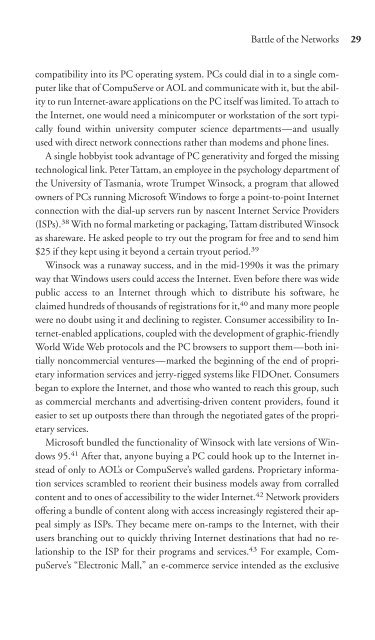Download - Future of the Internet â And how to stop it.
Download - Future of the Internet â And how to stop it.
Download - Future of the Internet â And how to stop it.
You also want an ePaper? Increase the reach of your titles
YUMPU automatically turns print PDFs into web optimized ePapers that Google loves.
Battle <strong>of</strong> <strong>the</strong> Networks 29<br />
compatibil<strong>it</strong>y in<strong>to</strong> <strong>it</strong>s PC operating system. PCs could dial in <strong>to</strong> a single computer<br />
like that <strong>of</strong> CompuServe or AOL and communicate w<strong>it</strong>h <strong>it</strong>, but <strong>the</strong> abil<strong>it</strong>y<br />
<strong>to</strong> run <strong>Internet</strong>-aware applications on <strong>the</strong> PC <strong>it</strong>self was lim<strong>it</strong>ed. To attach <strong>to</strong><br />
<strong>the</strong> <strong>Internet</strong>, one would need a minicomputer or workstation <strong>of</strong> <strong>the</strong> sort typically<br />
found w<strong>it</strong>hin univers<strong>it</strong>y computer science departments—and usually<br />
used w<strong>it</strong>h direct network connections ra<strong>the</strong>r than modems and phone lines.<br />
A single hobbyist <strong>to</strong>ok advantage <strong>of</strong> PC generativ<strong>it</strong>y and forged <strong>the</strong> missing<br />
technological link. Peter Tattam, an employee in <strong>the</strong> psychology department <strong>of</strong><br />
<strong>the</strong> Univers<strong>it</strong>y <strong>of</strong> Tasmania, wrote Trumpet Winsock, a program that allowed<br />
owners <strong>of</strong> PCs running Micros<strong>of</strong>t Windows <strong>to</strong> forge a point-<strong>to</strong>-point <strong>Internet</strong><br />
connection w<strong>it</strong>h <strong>the</strong> dial-up servers run by nascent <strong>Internet</strong> Service Providers<br />
(ISPs). 38 W<strong>it</strong>h no formal marketing or packaging, Tattam distributed Winsock<br />
as shareware. He asked people <strong>to</strong> try out <strong>the</strong> program for free and <strong>to</strong> send him<br />
$25 if <strong>the</strong>y kept using <strong>it</strong> beyond a certain tryout period. 39<br />
Winsock was a runaway success, and in <strong>the</strong> mid-1990s <strong>it</strong> was <strong>the</strong> primary<br />
way that Windows users could access <strong>the</strong> <strong>Internet</strong>. Even before <strong>the</strong>re was wide<br />
public access <strong>to</strong> an <strong>Internet</strong> through which <strong>to</strong> distribute his s<strong>of</strong>tware, he<br />
claimed hundreds <strong>of</strong> thousands <strong>of</strong> registrations for <strong>it</strong>, 40 and many more people<br />
were no doubt using <strong>it</strong> and declining <strong>to</strong> register. Consumer accessibil<strong>it</strong>y <strong>to</strong> <strong>Internet</strong>-enabled<br />
applications, coupled w<strong>it</strong>h <strong>the</strong> development <strong>of</strong> graphic-friendly<br />
World Wide Web pro<strong>to</strong>cols and <strong>the</strong> PC browsers <strong>to</strong> support <strong>the</strong>m—both in<strong>it</strong>ially<br />
noncommercial ventures—marked <strong>the</strong> beginning <strong>of</strong> <strong>the</strong> end <strong>of</strong> proprietary<br />
information services and jerry-rigged systems like FIDOnet. Consumers<br />
began <strong>to</strong> explore <strong>the</strong> <strong>Internet</strong>, and those who wanted <strong>to</strong> reach this group, such<br />
as commercial merchants and advertising-driven content providers, found <strong>it</strong><br />
easier <strong>to</strong> set up outposts <strong>the</strong>re than through <strong>the</strong> negotiated gates <strong>of</strong> <strong>the</strong> proprietary<br />
services.<br />
Micros<strong>of</strong>t bundled <strong>the</strong> functional<strong>it</strong>y <strong>of</strong> Winsock w<strong>it</strong>h late versions <strong>of</strong> Windows<br />
95. 41 After that, anyone buying a PC could hook up <strong>to</strong> <strong>the</strong> <strong>Internet</strong> instead<br />
<strong>of</strong> only <strong>to</strong> AOL’s or CompuServe’s walled gardens. Proprietary information<br />
services scrambled <strong>to</strong> reorient <strong>the</strong>ir business models away from corralled<br />
content and <strong>to</strong> ones <strong>of</strong> accessibil<strong>it</strong>y <strong>to</strong> <strong>the</strong> wider <strong>Internet</strong>. 42 Network providers<br />
<strong>of</strong>fering a bundle <strong>of</strong> content along w<strong>it</strong>h access increasingly registered <strong>the</strong>ir appeal<br />
simply as ISPs. They became mere on-ramps <strong>to</strong> <strong>the</strong> <strong>Internet</strong>, w<strong>it</strong>h <strong>the</strong>ir<br />
users branching out <strong>to</strong> quickly thriving <strong>Internet</strong> destinations that had no relationship<br />
<strong>to</strong> <strong>the</strong> ISP for <strong>the</strong>ir programs and services. 43 For example, CompuServe’s<br />
“Electronic Mall,” an e-commerce service intended as <strong>the</strong> exclusive


